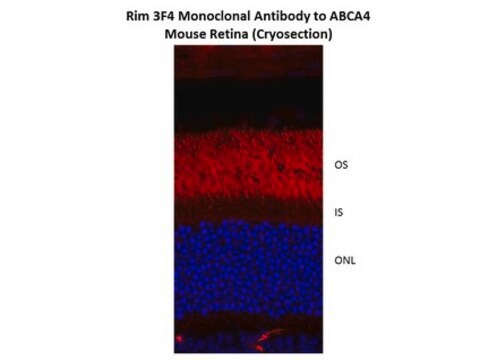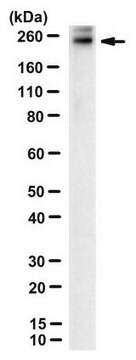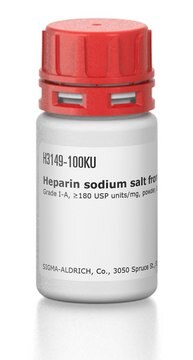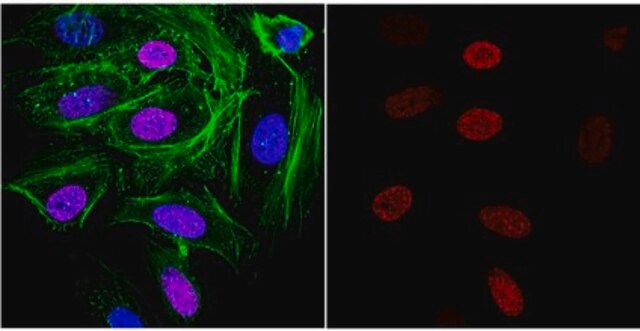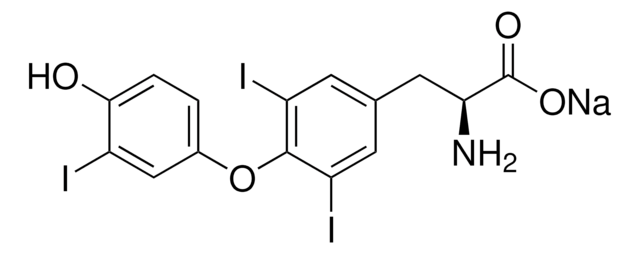MABN1775
Anti-ABCA4 Antibody, clone TMR1
clone TMR1, from mouse
Synonym(e):
Retinal-specific ATP-binding cassette transporter, ATP-binding cassette sub-family A member 4, RIM ABC transporter, RIM protein, RmP, Stargardt disease protein
About This Item
Empfohlene Produkte
Biologische Quelle
mouse
Qualitätsniveau
Antikörperform
purified antibody
Antikörper-Produkttyp
primary antibodies
Klon
TMR1, monoclonal
Speziesreaktivität
human, mouse
Speziesreaktivität (Voraussage durch Homologie)
bovine (based on 100% sequence homology)
Methode(n)
immunocytochemistry: suitable
immunofluorescence: suitable
western blot: suitable
Isotyp
IgG1κ
NCBI-Hinterlegungsnummer
UniProt-Hinterlegungsnummer
Versandbedingung
wet ice
Posttranslationale Modifikation Target
unmodified
Angaben zum Gen
human ... ABCA4(24)
Allgemeine Beschreibung
Ref.: Tsybovsky, Y et al. (2010). Adv. Exp. Med. Biol. 703, 105-125.
Spezifität
Immunogen
Anwendung
Neurowissenschaft
Immunocytochemistry Analysis: A representative lot detected similar cellular localization of wild-type and ABCA4 missense constructs with either or both L541P and A1038V mutation by fluorescent immunocytochemistry staining of 4% paraformaldehyde-fixed, 0.1% Triton X-100-permeabilized HEK293 transfectants (Zhang, N., et al. (2015). Hum. Mol. Genet. 24(11):3220-3237).
Immunofluorescence Analysis: A representative lot detected ABCA4 immunoreactivity in retina cryosections from wild-type mice and mice with heterozygous L541P;A1038V (PV) missense mutaion, but not mice with homozygous PV mutation (Zhang, N., et al. (2015). Hum. Mol. Genet. 24(11):3220-3237).
Qualität
Western Blotting Analysis: A 1:125 dilution of this antibody detected ABCA4 in 10 µg of human retina tissue lysate.
Zielbeschreibung
Physikalische Form
Lagerung und Haltbarkeit
Sonstige Hinweise
Haftungsausschluss
Sie haben nicht das passende Produkt gefunden?
Probieren Sie unser Produkt-Auswahlhilfe. aus.
Lagerklassenschlüssel
12 - Non Combustible Liquids
WGK
WGK 1
Analysenzertifikate (COA)
Suchen Sie nach Analysenzertifikate (COA), indem Sie die Lot-/Chargennummer des Produkts eingeben. Lot- und Chargennummern sind auf dem Produktetikett hinter den Wörtern ‘Lot’ oder ‘Batch’ (Lot oder Charge) zu finden.
Besitzen Sie dieses Produkt bereits?
In der Dokumentenbibliothek finden Sie die Dokumentation zu den Produkten, die Sie kürzlich erworben haben.
Unser Team von Wissenschaftlern verfügt über Erfahrung in allen Forschungsbereichen einschließlich Life Science, Materialwissenschaften, chemischer Synthese, Chromatographie, Analytik und vielen mehr..
Setzen Sie sich mit dem technischen Dienst in Verbindung.